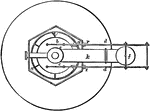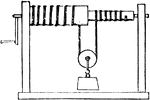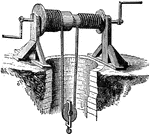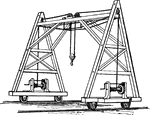Clipart tagged: ‘winch’

Langen's Collector
"Langens arrangement is a somewhat similar combination, the cone being made into a bell with perforated…

Langen's Collector
"Langens arrangement is a somewhat similar combination, the cone being made into a bell with perforated…
!["A still more common form, much used in drawing water from wells and loaded buckets from mines, is shown [here]. Instead of a wheel, we have here a winch, or handle, attached to the axle." —Quackenbos 1859](https://etc.usf.edu/clipart/36300/36345/winch_36345_mth.gif)
Winch
"A still more common form, much used in drawing water from wells and loaded buckets from mines, is shown…

Windlass
"Windlass.—The common windlass for drawing water is another modification of the wheel and axle.…

Chinese Windlass
A windlass is an apparatus for moving heavy weights. Typically, a windlass consists of a horizontal…
